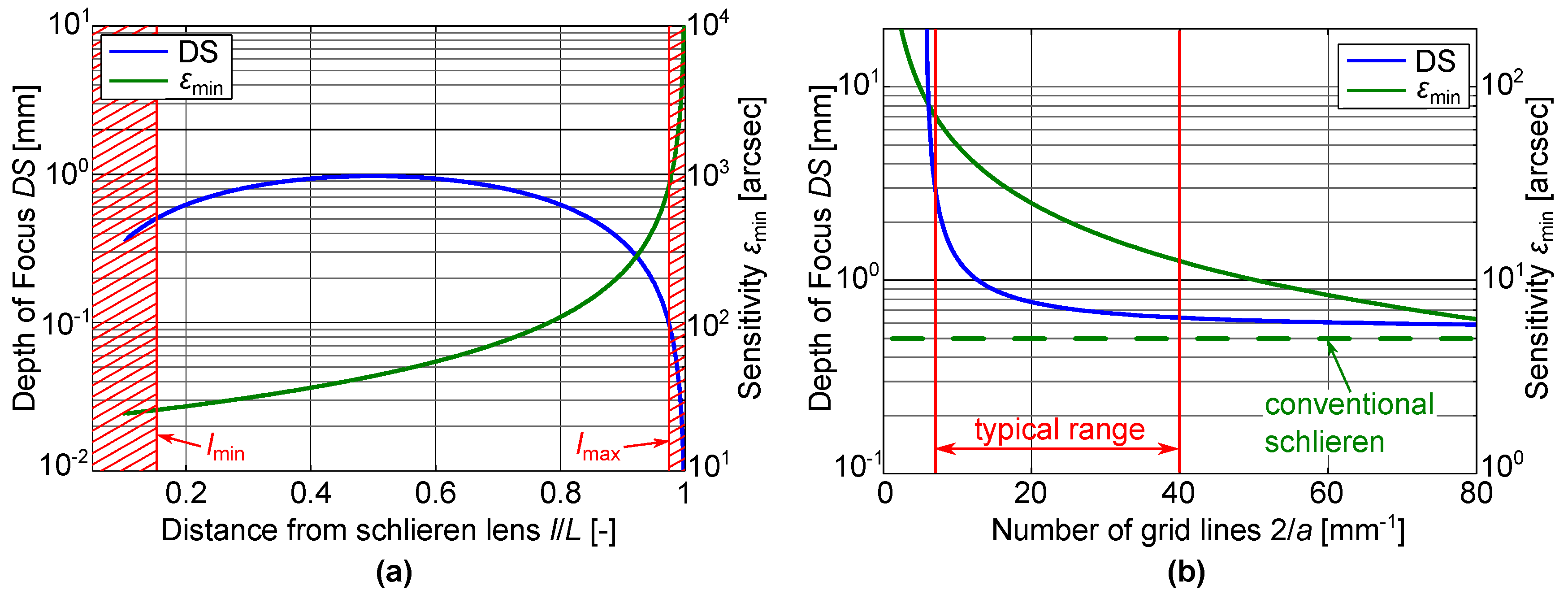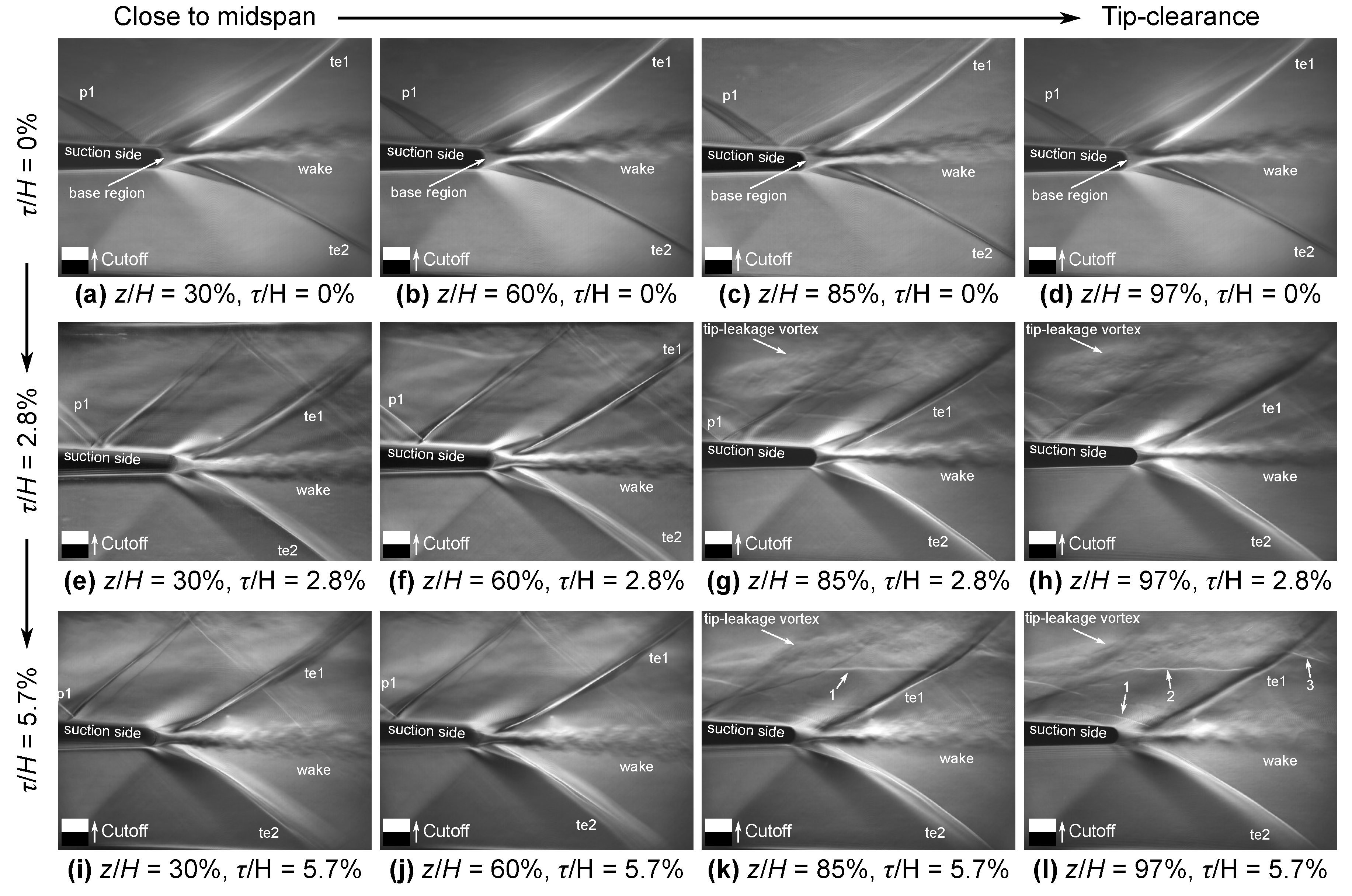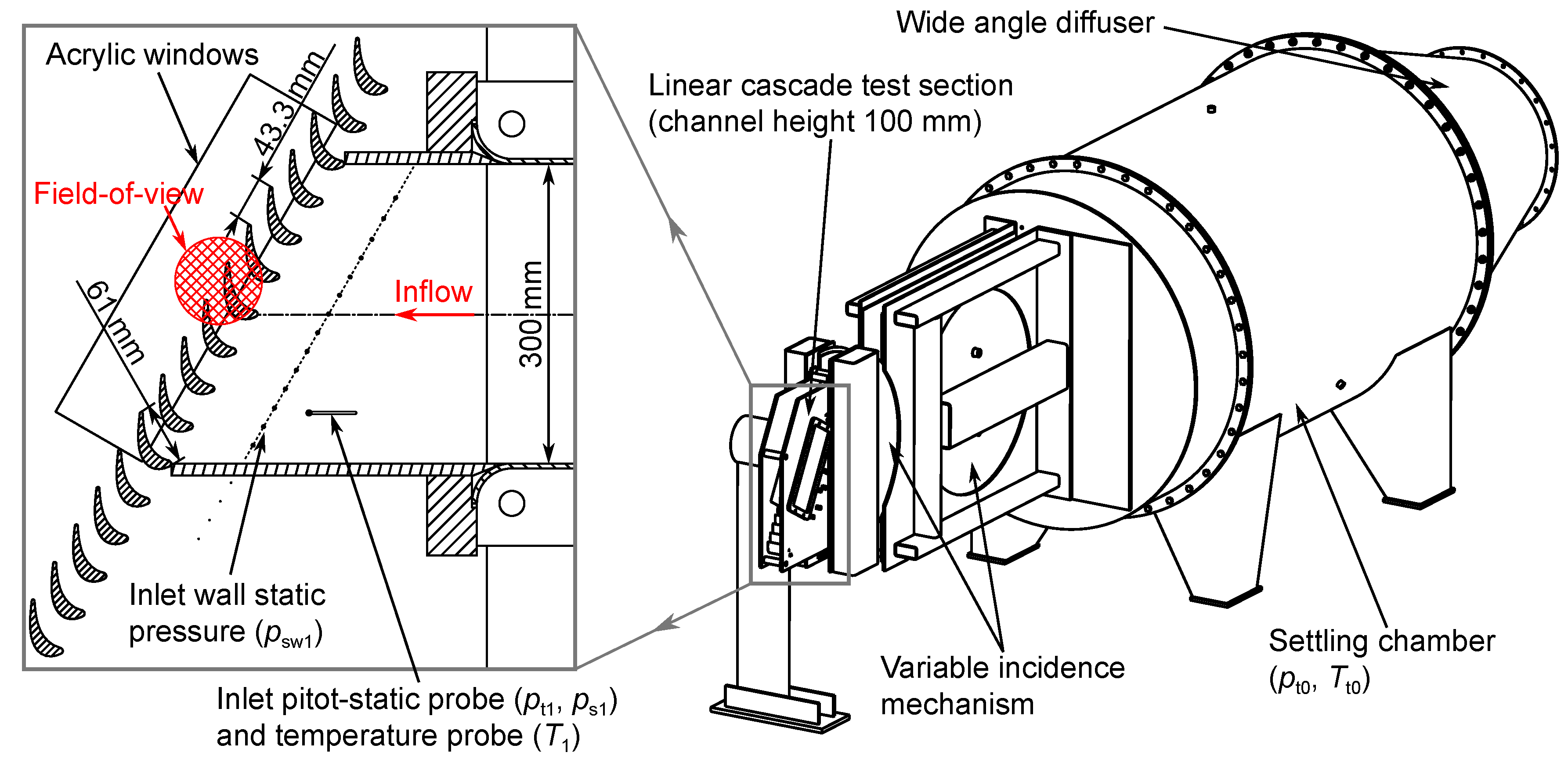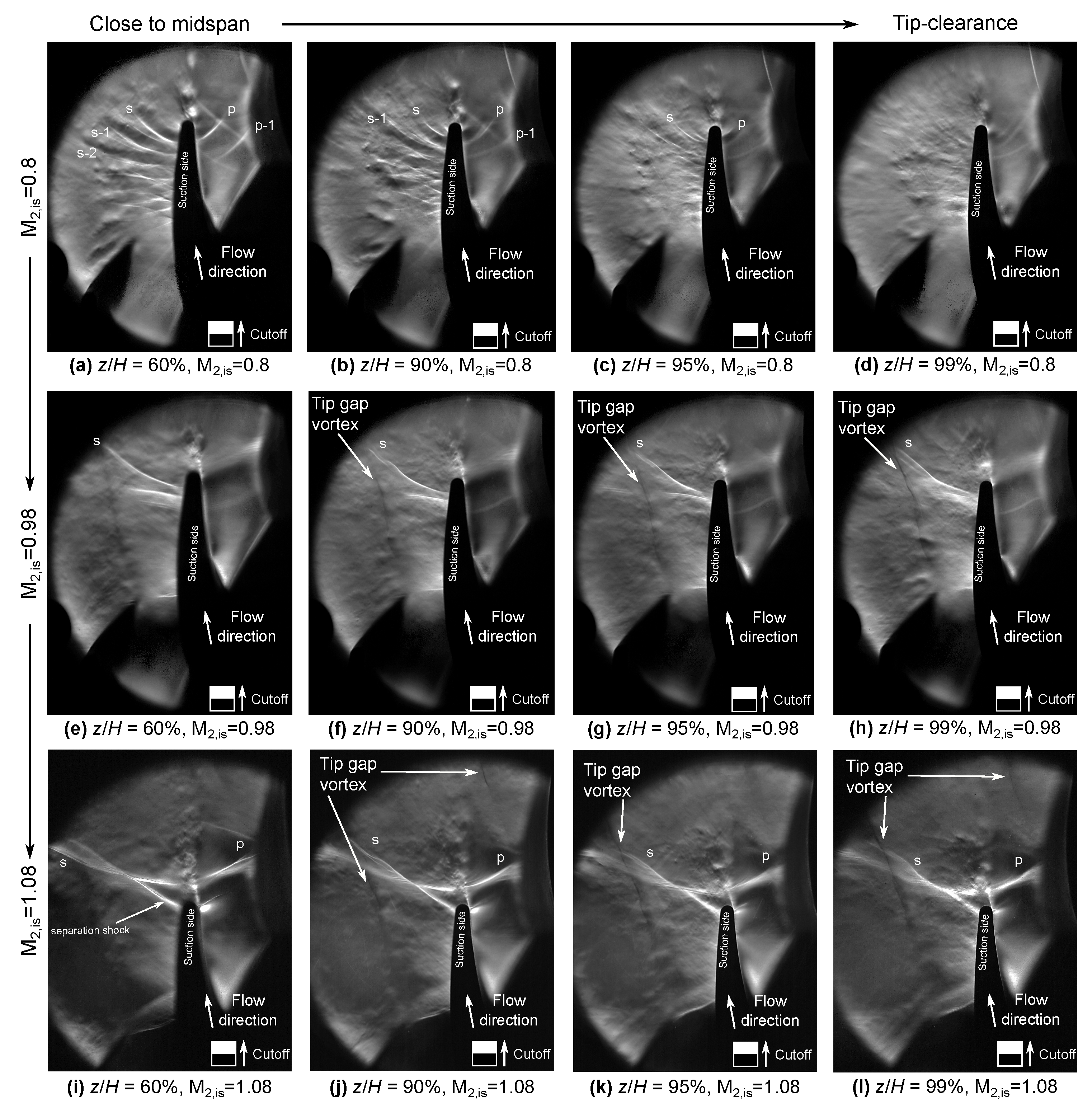Focusing Schlieren Visualization of Transonic Turbine Tip-Leakage Flows †
Abstract
:1. Introduction
2. Literature Review
3. Focusing Schlieren System
3.1. Optical Layout
3.2. System Properties
3.3. Validation of DOF
4. Application to Transonic Tip-Leakage Flows
4.1. Idealized Tip-Clearance Model
4.2. Transonic Turbine Cascade Tests
5. Summary
Author Contributions
Funding
Acknowledgments
Conflicts of Interest
Nomenclature
| a | unobstructed source image height |
| A | clear aperture of schlieren lens |
| b | distance between cutoff grid lines |
| c | chord length |
| d | diameter |
| trailing edge diameter | |
| depth of sharp focus | |
| depth of unsharp focus | |
| depth of focus | |
| f-number of schlieren lens | |
| F | focal length of schlieren lens |
| g | pitch |
| H | channel height |
| I | image intensity value |
| average image background intensity value | |
| k | Gladstone–Dale constant |
| L | distance from source grid to schlieren lens |
| distance from schlieren lens to cutoff grid | |
| l | distance from schlieren object to schlieren lens |
| distance from schlieren lens to image plane | |
| m | magnification of image, |
| Mach number | |
| n | number of grid lines per millimeter at cutoff grid |
| p | pressure |
| angle change resulting in brightness change | |
| pairs of lines involved in forming each point in focusing schlieren image | |
| wavelength of light | |
| tip-clearance height |
References
- Dixon, S.L.; Hall, C. Fluid Mechanics and Thermodynamics of Turbomachinery, 7th ed.; Butterworth-Heinemann: Oxford, UK, 2013. [Google Scholar]
- Denton, J. Loss Mechanisms in Turbomachines. ASME J. Turbomach. 1993, 115, 621–656. [Google Scholar] [CrossRef]
- Wheeler, A.; Korakianitis, T.; Banneheke, S. Tip-Leakage Losses in Subsonic and Transonic Blade Rows. ASME J. Turbomach. 2013, 135, 011029. [Google Scholar] [CrossRef]
- Moore, J.; Elward, K. Shock Formation in Overexpanded Tip Leakage Flow. ASME J. Turbomach. 1993, 115, 392–399. [Google Scholar] [CrossRef]
- Jackson, A.; Wheeler, A.; Ainsworth, R. An Experimental and Computational Study of Tip Clearance Effects on a Transonic Turbine Stage. Int. J. Heat Fluid Fl. 2015, 56, 335–343. [Google Scholar] [CrossRef] [Green Version]
- Wheeler, A.; Sandberg, R. Numerical Investigation of the Flow Over a Model Transonic Turbine Blade Tip. J. Fluid Mech. 2016, 803, 119–143. [Google Scholar] [CrossRef] [Green Version]
- Dorney, D.; Griffin, L.; Huber, F. A Study of the Effects of Tip Clearance in a Supersonic Turbine. ASME J. Turbomach. 2000, 122, 674–683. [Google Scholar] [CrossRef]
- Wheeler, A.; Saleh, Z. Effect of Cooling Injection on Transonic Tip Flows. AIAA J. Propul. Power 2013, 29, 1374–1381. [Google Scholar] [CrossRef]
- Graham, C.; Kost, F. Shock Boundary Layer Interaction on High Turning Transonic Turbine Cascades. In Proceedings of the International Gas Turbine Conference and Exhibit and Solar Energy Conference, San Diego, CA, USA, 12–15 March 1979. [Google Scholar] [CrossRef]
- Kiock, R.; Lehthaus, F.; Baines, N.; Sieverding, C. The Transonic Flow Through a Plane Turbine Cascade as Measured in Four European Wind Tunnels. ASME J. Eng. Gas Turb. Power 1986, 108, 277–284. [Google Scholar] [CrossRef]
- Melzer, A.; Pullan, G. The Role of Vortex Shedding in the Trailing Edge Loss of Transonic Turbine Blades. ASME J. Turbomach. 2019, 141, 041001. [Google Scholar] [CrossRef] [Green Version]
- Settles, G. Schlieren and Shadowgraph Techniques: Visualizing Phenomena in Transparent Media; Springer Science Business Media: Berlin, Germany, 2012. [Google Scholar]
- Toepler, A. Beobachtungen Nach Einer Neuen Optischen Methode: Ein Beitrag zur Experimental-Physik; Max Cohen & Sohn: Bonn, Germany, 1864. [Google Scholar]
- Schardin, H. Die Schlierenverfahren und ihre Anwendungen. In Ergebnisse der Exakten Naturwissenschaften; Springer: Berlin, Germany, 1942; pp. 303–439. [Google Scholar]
- Kantrowitz, A.; Trimpi, R. A Sharp-Focusing Schlieren System. J. Aeronaut. Sci. 1950, 17, 311–314. [Google Scholar] [CrossRef]
- Burton, R. A Modified Schlieren Apparatus for Large Areas of Field. J. Opt. Soc. Am. 1949, 39, 907–908. [Google Scholar] [CrossRef] [PubMed]
- Burton, R. Notes on the Multiple Source Schlieren System. J. Opt. Soc. Am. 1951, 41, 858–859. [Google Scholar] [CrossRef]
- Weinstein, L. Large-Field High-Brightness Focusing Schlieren System. AIAA J. 1993, 31, 1250–1255. [Google Scholar] [CrossRef]
- Weinstein, L. Review and Update of Lens and Grid Schlieren and Motion Camera Schlieren. Eur. Phys. J. Spec. Top. 2010, 182, 65–95. [Google Scholar] [CrossRef]
- Alvi, F.; Settles, G.; Weinstein, L. A Sharp-Focusing Schlieren Optical Deflectometer. In Proceedings of the 31st Aerospace Sciences Meeting, Reno, NV, USA, 11–14 January 1993. [Google Scholar]
- Garg, S.; Settles, G. Measurements of a Supersonic Turbulent Boundary Layer by Focusing Schlieren Deflectometry. Exp. Fluids 1998, 25, 254–264. [Google Scholar] [CrossRef]
- Gartenberg, E.; Weinstein, L.; Lee, E. Aerodynamic Investigation With Focusing Schlieren in a Cryogenic Wind Tunnel. AIAA J. 1994, 32, 1242–1249. [Google Scholar] [CrossRef]
- Taghavi, R.; Raman, G. Visualization of Supersonic Screeching Jets Using a Phase Conditioned Focusing Schlieren System. Exp. Fluids 1996, 20, 472–475. [Google Scholar] [CrossRef]
- Cook, S.; Chokani, N. Quantitative Results From the Focusing Schlieren Technique. In Proceedings of the 31st Aerospace Sciences Meeting, Reno, NV, USA, 11–14 January 1993. [Google Scholar]
- VanDercreek, C.; Smith, M.; Yu, K. Focused Schlieren and Deflectometry at AEDC Hypervelocity Wind Tunnel No. 9. In Proceedings of the 27th AIAA Aerodynamic Measurement Technology and Ground Testing Conference, Chicago, IL, USA, 28 June–1 July 2010. [Google Scholar]
- Kouchi, T.; Goyne, C.; Rockwell, R.; McDaniel, J. Focusing-Schlieren Visualization in a Dual-Mode Scramjet. Exp. Fluids 2015, 56, 211. [Google Scholar] [CrossRef] [Green Version]
- Kouchi, T.; Masuya, G.; Yanase, S. Extracting Dominant Turbulent Structures in Supersonic Flow Using Two-Dimensional Fourier Transform. Exp. Fluids 2017, 58, 98. [Google Scholar] [CrossRef]
- Bühler, M.; Förster, F.; Dröske, N.; von Wolfersdorf, J.; Weigand, B. Design of a Focusing Schlieren Setup for Use in a Supersonic Combustion Chamber. In Proceedings of the 30th International Symposium on Shock Waves 2, Tel-Aviv, Israel, 19–24 July 2015; pp. 1467–1471. [Google Scholar] [CrossRef]
- Fish, R.; Parnham, K. Focusing Schlieren Systems; Report CP-54; Aeronautical Research Council: London, UK, 1950. [Google Scholar]
- Sieverding, C.; Decuypere, R.; Hautot, P. Investigation of Transonic Steam Turbine Tip Sections With Various Suction Side Blade Curvatures. In Proceedings of the Inst. of Mech. Engr. Design Conf. on Steam Turbines for the 1980’s, London, UK, October 1979; pp. 241–251. [Google Scholar]
- Passmann, M.; aus der Wiesche, S.; Joos, F. An Experimental and Numerical Study of Tip-Leakage Flows in an Idealized Turbine Tip Gap at High Mach Numbers. In Proceedings of the ASME Turbo Expo 2018: Turbomachinery Technical Conference and Exposition, Oslo, Norway, 11–15 June 2018. [Google Scholar]
- Sieverding, C.; Stanislas, M.; Snoeck, J. The Base Pressure Problem in Transonic Turbine Cascades. ASME J. Eng. Power 1980, 102, 711–718. [Google Scholar] [CrossRef]
- Denton, J.; Xu, L. The Trailing Edge Loss of Transonic Turbine Blades. ASME J. Turbomach. 1990, 112, 277–285. [Google Scholar] [CrossRef]
- Ober, B. Experimental Investigation on the Aerodynamic Performance of a Compressor Cascade in Droplet Laden Flow. Ph.D. Thesis, Helmut-Schmidt-Universität, Hamburg, Germany, 2013. [Google Scholar]











| L (mm) | (mm) | l (mm) | (mm) | (m) | (mm) | (mm) | (-) | (arcsec) | |
|---|---|---|---|---|---|---|---|---|---|
| Setup for idealized model tests | 850 | 94.5 | 110 | 374 | 100 | ±0.3 | ±3.6 | 24 | 25 |
| Setup for linear cascade tests | 850 | 94.5 | 120 | 291.5 | 100 | ±0.28 | ±3.9 | 26 | 25.4 |
| Kouchi et al. [26] | 640 | 98 | 110 | 374 | 70 | ±0.5 | ±3.6 | 36 | 17 |
| Bühler et al. [28] | 640 | 98 | 128 | 192 | - | - | ±4.2 | - | - |
© 2020 by the authors. Licensee MDPI, Basel, Switzerland. This article is an open access article distributed under the terms and conditions of the Creative Commons Attribution (CC BY) license (http://creativecommons.org/licenses/by/4.0/).
Share and Cite
Passmann, M.; aus der Wiesche, S.; Joos, F. Focusing Schlieren Visualization of Transonic Turbine Tip-Leakage Flows. Int. J. Turbomach. Propuls. Power 2020, 5, 1. https://doi.org/10.3390/ijtpp5010001
Passmann M, aus der Wiesche S, Joos F. Focusing Schlieren Visualization of Transonic Turbine Tip-Leakage Flows. International Journal of Turbomachinery, Propulsion and Power. 2020; 5(1):1. https://doi.org/10.3390/ijtpp5010001
Chicago/Turabian StylePassmann, Maximilian, Stefan aus der Wiesche, and Franz Joos. 2020. "Focusing Schlieren Visualization of Transonic Turbine Tip-Leakage Flows" International Journal of Turbomachinery, Propulsion and Power 5, no. 1: 1. https://doi.org/10.3390/ijtpp5010001




